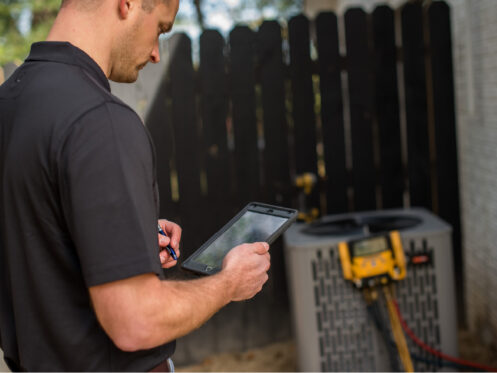Air conditioners are designed not only to cool your home but also to remove humidity from the air, which often leads to the formation of condensation. At Cozy Home Services, we frequently address queries about AC units dripping water. Let’s explore why this happens and when it might indicate a problem.
Explanation of AC Condensation
To understand why air conditioners sometimes drip water, it would be helpful to first understand the AC condensation process.
Cooling Process and Moisture Removal
The cooling process begins as your air conditioner draws in warm, humid air from your environment. This air is then passed over the evaporator coil, which is significantly cooler, usually due to the presence of refrigerant circulating within it.
As the warm air comes in contact with the cold surface of the coil, the temperature of the air drops rapidly. This rapid cooling causes the moisture in the air to transition from a gaseous to a liquid state, a process known as condensation.
Similar to how water droplets form on the outside of a cold glass on a hot day, moisture condenses on the cold evaporator coil. This condensation is a natural byproduct of the cooling process and is crucial for reducing the humidity levels within your home, contributing to a more comfortable indoor environment.
The moisture that forms on the evaporator coil is collected in a drip pan located beneath it. From here, it is channeled away from the AC unit through a condensate drain line. This drainage is an essential aspect of the air conditioner’s design as it prevents moisture from accumulating within the system. This could lead to issues like water damage, mold growth, or system inefficiency.
By removing excess moisture from the air, your air conditioner helps maintain a balanced humidity level indoors. This not only enhances comfort but also improves the overall indoor air quality. High humidity levels indoors can lead to the growth of mold and mildew, whereas properly conditioned air reduces this risk.
Condensate Drain Line
The condensate drain line is a vital component of your air conditioning system, playing a key role in the proper disposal of the moisture accumulated during the cooling process. This moisture, which forms on the cold surfaces of the evaporator coil, drips down into a specially designed drain pan. From here, it enters the condensate drain line, a pipeline that safely channels the water out of the AC unit and your home.
The primary purpose of the condensate drain line is to prevent water from accumulating inside your air conditioning system or inside your home. Without this line functioning correctly, water could back up, leading to potential water damage, increased humidity levels, and even the growth of mold or mildew. These issues could have detrimental effects on both your AC system and indoor air quality.
Normal Causes of Water Dripping from Your AC
Condensation on Evaporator Coil
It’s normal for your AC to produce some amount of condensation as it operates, especially on hot or humid days. This is a byproduct of the cooling process and is usually handled effectively by the unit’s drainage system.
On particularly hot or humid days, the air contains more moisture. Consequently, as this humid air passes over the evaporator coil, more condensation is produced. This is a normal reaction and is indicative of your AC unit effectively removing humidity from your indoor environment, contributing to a more comfortable indoor climate.
The presence of condensation on the evaporator coil and the associated dripping into the drain pan signifies that your air conditioner is working as intended. It’s removing humidity from the air, which is a key component of the cooling process, especially in areas with high humidity levels.
Drain Pan and Line Clearance
The drain pan, typically located beneath the evaporator coil, catches condensation that forms on the coil. This water is then channeled out of the AC unit and your home through the drain line. The efficient operation of this drainage system is crucial in preventing water from accumulating and overflowing.
Over time, dust, dirt, and other forms of debris can accumulate in the drain pan and line. This buildup can occur from normal air circulation through the unit, bringing in particles that settle in these areas.
Humidity Levels and Location
Air conditioners in regions with high humidity levels are prone to producing more condensation. Humid air contains more moisture, and when this air passes over the cold evaporator coils of your AC, it results in a higher volume of water being condensed.
This natural process is part of how air conditioners cool and dehumidify your space, but it can also lead to more water accumulating in the drain pan, and potentially, more dripping if the drainage system is not adequately managing the increased water flow.
Signs of Potential Issues with AC Dripping Water
Excessive water leaking or pooling around your AC indicates a sign of a malfunction, such as a clogged drain line or a malfunctioning pump. Musty smells or discoloration around your AC unit or vents indicates water is not being properly drained. And water leaking inside your home around your AC unit indicates a serious issue that requires immediate attention.
Preventative Measures for AC Maintenance
Regular Filter Changes
The primary function of an AC filter is to trap and hold various airborne particles, including dust, pollen, and other contaminants. Over time, these particles accumulate on the filter, which can lead to significant obstructions in airflow. When airflow is impeded, it can cause the evaporator coils to freeze, leading to water overflows and increased condensation as the coils thaw.
Regular filter changes ensure that your air conditioning system operates as efficiently as possible. Clean filters allow for optimal airflow, which not only improves cooling efficiency but also prevents the system from overworking. An overworked system can lead to increased wear and tear on components and potentially higher energy bills.
Schedule Professional Maintenance
Scheduling regular professional maintenance is a cornerstone of effective air conditioning care, essential for both the performance and longevity of your AC unit. Professional maintenance typically includes a thorough inspection of all AC components.
Our technicians from Cozy Home Services check not just the filter and refrigerant levels but also delve into the electrical connections, the condition of the evaporator and condenser coils, and the functionality of the thermostat, among other elements.
Another key part of regular, professional maintenance is ensuring that the AC’s drainage system is functioning correctly. Over time, the condensate drain line can become clogged with algae, dirt, or debris, leading to improper water drainage and potential dripping issues. Professional maintenance includes cleaning and inspecting this line to prevent water backup and overflow.
Ensuring Efficient AC Operation With Our Team
Water dripping from your AC unit can be normal, but it’s important to recognize the signs of potential problems and contact us for AC repair. Cozy Home Services in Vacaville, CA, is here to help with all your AC maintenance needs, ensuring your system runs smoothly and keeps your home comfortable. Contact us to schedule an appointment. We offer heating, cooling, and plumbing services.



